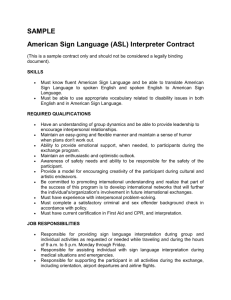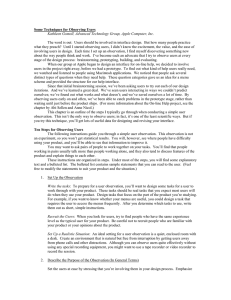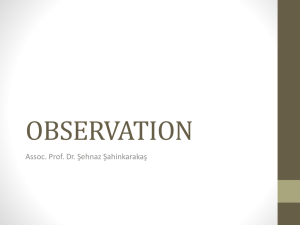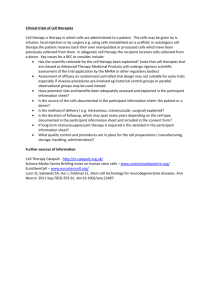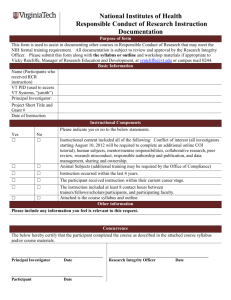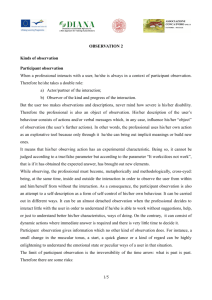Guidelines for `good` participant observation
advertisement
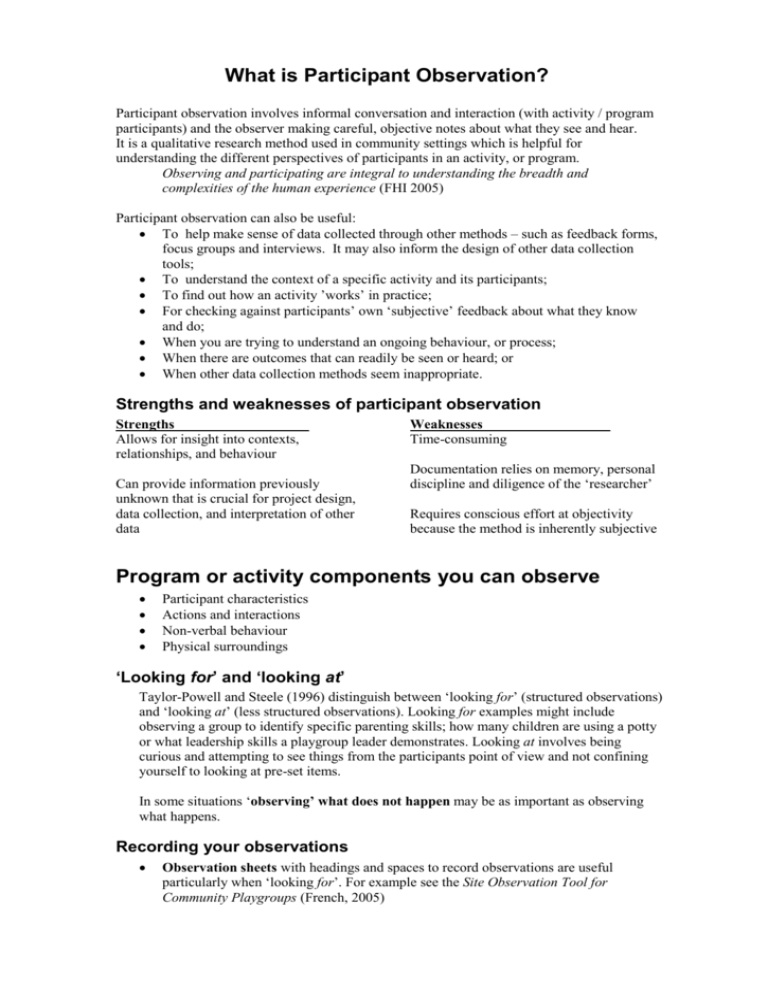
What is Participant Observation? Participant observation involves informal conversation and interaction (with activity / program participants) and the observer making careful, objective notes about what they see and hear. It is a qualitative research method used in community settings which is helpful for understanding the different perspectives of participants in an activity, or program. Observing and participating are integral to understanding the breadth and complexities of the human experience (FHI 2005) Participant observation can also be useful: To help make sense of data collected through other methods – such as feedback forms, focus groups and interviews. It may also inform the design of other data collection tools; To understand the context of a specific activity and its participants; To find out how an activity ’works’ in practice; For checking against participants’ own ‘subjective’ feedback about what they know and do; When you are trying to understand an ongoing behaviour, or process; When there are outcomes that can readily be seen or heard; or When other data collection methods seem inappropriate. Strengths and weaknesses of participant observation Strengths___________________ Allows for insight into contexts, relationships, and behaviour Can provide information previously unknown that is crucial for project design, data collection, and interpretation of other data Weaknesses__________________ Time-consuming Documentation relies on memory, personal discipline and diligence of the ‘researcher’ Requires conscious effort at objectivity because the method is inherently subjective Program or activity components you can observe Participant characteristics Actions and interactions Non-verbal behaviour Physical surroundings ‘Looking for’ and ‘looking at’ Taylor-Powell and Steele (1996) distinguish between ‘looking for’ (structured observations) and ‘looking at’ (less structured observations). Looking for examples might include observing a group to identify specific parenting skills; how many children are using a potty or what leadership skills a playgroup leader demonstrates. Looking at involves being curious and attempting to see things from the participants point of view and not confining yourself to looking at pre-set items. In some situations ‘observing’ what does not happen may be as important as observing what happens. Recording your observations Observation sheets with headings and spaces to record observations are useful particularly when ‘looking for’. For example see the Site Observation Tool for Community Playgroups (French, 2005) A notebook in which either brief notes about observations are recorded at the time and then narratives expanded on later, or observations are committed to memory and notes are made later. This less-structured approach requires greater discipline on the part of the observer to make time to write up notes immediately following the observation session while memories are still fresh. Ethical considerations Do participants need to know they are being observed? Generally speaking you are not under any specific obligation to reveal to the participants that you are attending any activity for the purpose of participant observation. However, think about the particular context and the people you will be observing. Would they appreciate knowing why you are there? Might this hinder the quality of data gathered in any way? Be discreet enough about who you are and what you are doing that you do not disrupt normal activity, yet open enough that the people you observe and interact with do not feel that your presence compromises their privacy (FHI 2005) Maintaining confidentiality It is important to protect the identities of the people (parents/carers/teachers/children) you observe and interact with. This means that you must not record (in your notes) any identifying information that could link participants observed with ‘data’ they provided. It also involves not divulging personal characteristics that could allow others (outside of your immediate team) to guess the identity of participants Guidelines for ‘good’ participant observation Think about whether you will explain to participants why you are there; Plan how (if you will) take notes during the observation; Be descriptive, not interpretative, with your notes; Gather a variety of information from the perspectives of different participants; Triangulate (compare) what you observed with other activity data gathered e.g. interviews, focus groups, feedback sheets, anecdotal evidence etc.; Be as involved as possible in the activity while maintaining a curious and alert mind; and If using a notebook record your own thoughts, feelings and experiences as well as your observations. Remember that developing good observational skills is something that is learned over time with practice. Sensitivity to participants and the specific context, a curious and alert mind, and disciplined recording are the path to becoming a competent observer! Resources and references Family Health Initiative (2005) Module 2 Participant Observation in Qualitative Research Methods: A Data Collector’s Field Guide Taylor-Powell, E. and Steele, S. (1996) Collecting Evaluation Data: Direct Observation University of Wisconsin Extension French, G. (2005) Appendix 3 Site Observation Tool pp. 82-92 in Valuing Community Playgroups: Lessons for practice and policy, Katherine Howard Foundation Jones, L. and Somekh, B. (2005) Observation pp 138-144 in Somekh and Lewin (2005) Research Methods in the Social Sciences, SAGE Publication, London UK



